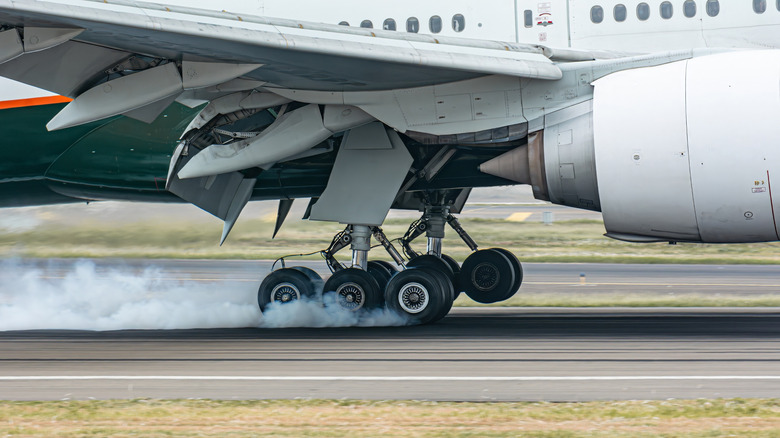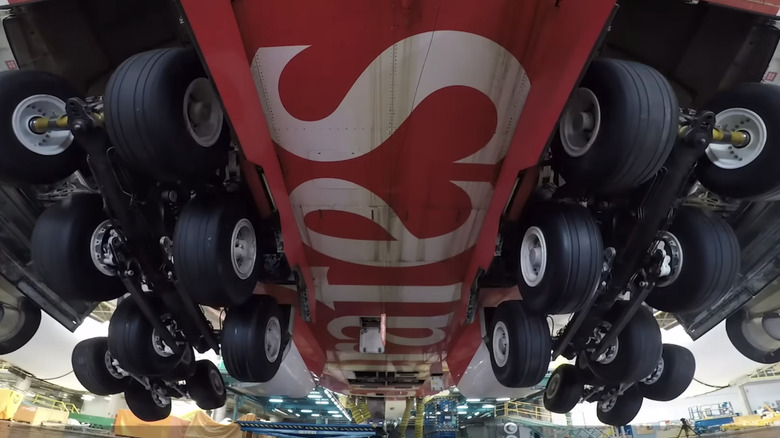Here's How A Commercial Jet's Suspension Works
To understand how a commercial jet's suspension works, it helps to first imagine a jet without suspension. The first aircraft landing gear systems were indeed that way. Engineers essentially welded the wheels directly onto the plane's frame – a design called a rigid strut. This meant any bumpy landing transferred a massive shock straight into the airframe, which is not ideal when you're trying to keep a long metal tube in one piece. Commercial jets are also incredibly heavy, with a plane like the Airbus A380 boasting a mind-boggling maximum takeoff weight of 1.254 million pounds.
To handle these insane forces, nearly all modern jets rely on a sophisticated piece of engineering called an oleo-pneumatic shock strut, or "oleo strut" for short. It's the most widely used type of shock absorber in aircraft these days. An oleo strut consists of two telescoping cylinders with sealed ends. The top cylinder connects to the aircraft, while the bottom cylinder, known as the piston, is attached to the wheels and slides inside the upper cylinder. The system is pneumatic and hydraulic, meaning it uses both gas and oil to absorb shock. The bottom chamber is filled with hydraulic fluid, while the upper chamber contains a compressed gas, typically nitrogen.
When the jet touches down, the piston moves upward, forcing the hydraulic fluid through a small hole (or orifice) into the gas-filled chamber. The compressed gas acts like a spring and takes the initial hit. But everything after that is handled by the fluid moving through that tiny hole. As it moves through the hole, all that kinetic energy from the landing is converted into thermal energy, which effectively dissipates the impact. This hydraulic damping also prevents the aircraft from bouncing off the runway.
Why not just use car-style suspension?
You might wonder why planes don't ditch all that complexity and go for simpler strut-and-shock-based suspension systems, like the kind found in your car. Some less complicated aircraft do use single-strut designs that incorporate the spring and shock absorbers. This does make them very much like the MacPherson struts in cars. The problem is that these systems aren't very efficient and work best when they're relatively smaller. For heavier aircraft like a commercial jet, any springs needed as part of single-strut designs would have to be huge. A bigger issue is recoil. Spring-based systems are notoriously bad at damping the bounce-back from a hard landing. All the energy absorbed by the spring gets released in a powerful bounce, which can be dangerous.
Lighter aircraft, however, have several other options that work just fine. We already mentioned rigid struts, the earliest and simplest form of landing gear. The only real shock absorption came from the plane's inflatable tires. This concept is also used widely in many modern helicopters — they feature rigid metal skids attached directly to the fuselage.
Another common system is the spring steel strut. There are no pistons or fluids here, as the landing gear itself is the suspension. The plane lands on a pair of flexible legs that literally bow upwards. That's simple enough, but things get even more low-tech with bungee cords. Often found on tailwheel planes, this system is basically just a web of elastic bands spanning between the gear and the fuselage. They stretch as the landing gear stretches during touchdown, dampening the impact.

